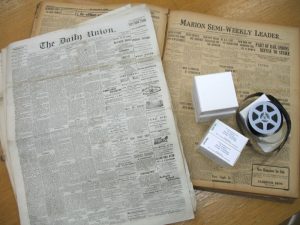The Illinois Newspaper Project (INP) currently focuses its preservation work on newspapers in the collections of the University of Illinois Library. However, we also provide guidance on best practices to Illinois libraries and historical societies that wish to preserve their own print newspaper collections.
Most of our preservation microfilming work was performed during the 20 year statewide survey, funded by a grant from the National Endowment for the Humanities (NEH). As part of the statewide survey, we made note of titles that had not yet been preserved on microfilm.
Since we couldn’t film everything, we used a formula based on the following criteria to select newspapers for preservation microfilming:
- What is the scope of coverage?
- How rare is the material?
- Is there a significant run or only a few scattered issues?
- How complete is the run?
- Has it been microfilmed previously?
- Will these issues supplement previously filmed holdings?
- What is the condition of the original newsprint?
- What is the research value of the newspaper?
After we selected a newspaper for preservation microfilming, the INP sought permission from the holding institution to borrow their copy. We picked up the material and brought it back to the University of Illinois Library for processing. Before shipping to our microfilm vendor, we performed a page-by-page collation, if the condition of the newsprint permitted. This allowed us to note irregularities, make repairs before filming, and create “targets” with identifying information that would be filmed with the original newsprint. Finally, we made the necessary additions or corrections to our database (the Illinois Newspaper Directory, formerly called the Illinois Newspaper Project Database) to reflect any new information we gleaned.
The INP used four different vendors for preservation microfilming. We, along with these vendors, closely adhered to the preservation microfilming guidelines that were mandated by the U.S. Newspaper Program and the Library of Congress. After the newsprint and microfilm were returned to us, we inspected all three generations of microfilm a second time to ensure quality control.
The Abraham Lincoln Presidential Library (ALPL) is the main institution responsible for preserving Illinois newspapers. They currently receive and microfilm over 250 titles from all across the state, but there remain in hundreds of Illinois newspapers not actively collected or preserved.
What We’ve Filmed

At our project’s end, the INP had microfilmed 480 titles. A service copy of all microfilm created by the INP is available through interlibrary loan at the University of Illinois Library. Patrons and institutions also have the opportunity to purchase service copies of the microfilm.